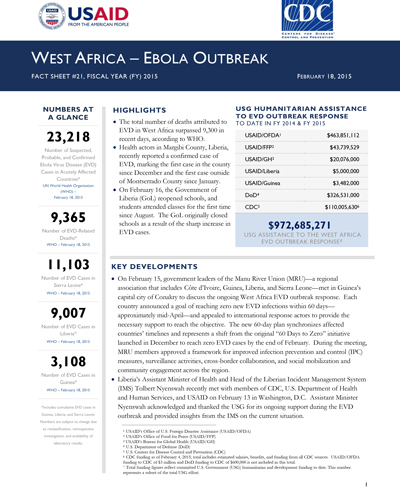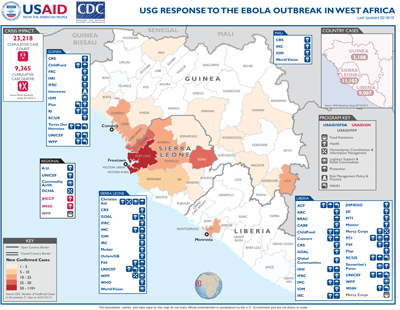February 18, 2015
HIGHLIGHTS
Ebola Response
Visit our main West Africa Ebola Outbreak page to learn more about how we're responding to the West Africa Ebola outbreak, and what you can do to help.
- The total number of deaths attributed to EVD in West Africa surpassed 9,300 in recent days, according to WHO.
- Health actors in Margibi County, Liberia, recently reported a confirmed case of EVD, marking the first case in the county since December and the first case outside of Montserrado County since January.
- On February 16, the Government of Liberia (GoL) reopened schools, and students attended classes for the first time since August. The GoL originally closed schools as a result of the sharp increase in EVD cases.
West Africa - Ebola Outbreak Fact Sheet #21 (FY 15) ![]() (pdf - 298k)
(pdf - 298k)
KEY DEVELOPMENTS
- On February 15, government leaders of the Manu River Union (MRU)—a regional association that includes Côte d’Ivoire, Guinea, Liberia, and Sierra Leone—met in Guinea’s capital city of Conakry to discuss the ongoing West Africa EVD outbreak response. Each country announced a goal of reaching zero new EVD infections within 60 days—approximately mid-April—and appealed to international response actors to provide the necessary support to reach the objective. The new 60-day plan synchronizes affected countries’ timelines and represents a shift from the original “60 Days to Zero” initiative launched in December to reach zero EVD cases by the end of February. During the meeting, MRU members approved a framework for improved infection prevention and control (IPC) measures, surveillance activities, cross-border collaboration, and social mobilization and community engagement across the region.
- Liberia’s Assistant Minister of Health and Head of the Liberian Incident Management System (IMS) Tolbert Nyenswah recently met with members of CDC, U.S. Department of Health and Human Services, and USAID on February 13 in Washington, D.C. Assistant Minister Nyenswah acknowledged and thanked the USG for its ongoing support during the EVD outbreak and provided insights from the IMS on the current situation.
CURRENT SITUATION
Total weekly case incidence slightly decreased by approximately 11 percent across West Africa in the past week, with 128 new confirmed cases recorded between February 8 and 15, according to WHO. While transmission remains widespread in Sierra Leone, with 74 new confirmed cases, Guinea only reported 52 new confirmed cases—the first week-to-week decline since January 25. The majority of the new confirmed cases in Guinea are in Conakry and Forécariah Prefecture, with 13 and 24 cases, respectively.
West Africa Ebola Map #21 February 18, 2015 ![]() (pdf - 777k)
(pdf - 777k)
Liberia
Between February 10 and 16, the GoL reported five new confirmed EVD cases in Margibi and Montserrado. All of the new cases are related to the only known active chain of transmission in Liberia—a cluster from the St. Paul Bridge area of Montserrado. As of February 16, the GoL had reported 14 confirmed EVD cases during the previous 21 days.
Approximately 220 households from four communities near Kakata town, Margibi, remain under observation following the county’s first EVD case in eight weeks. International Medical Corps (IMC) admitted nine additional individuals with EVD-related symptoms to the USAID/OFDA-supported EVD treatment unit (ETU) in Kakata on February 15 and 16. Initial EVD laboratory test results for at least six of the new patients were negative as of February 17.
To date, eight USG-supported laboratories in Liberia have provided critical support for the EVD response, such as diagnostic capacity to enable the rapid identification of EVD. Given the decline in countrywide EVD cases, as well as the contingent nature of some laboratories, USG-supported laboratories are transitioning towards a long-term sustainable arrangement. To ensure adequate testing capacity during the transition, three USG-supported laboratories plan to retain full operations—the Liberian Institute of Biomedical Research in Margibi, the Cuttington University site in Bong County, and the ELWA facility in Montserrado. Additional laboratory specimen hubs will be available in Nimba and Maryland counties. The DoD laboratories at Island Clinic in Montserrado and Zwedru town, Grand Gedeh County, closed on January 26 and February 12, respectively. The DoD-supported laboratories located in Greenville town, Sinoe County, and Sanniquellie and Tappita towns in Nimba, are expected to close during the week of February 16.
Between February 8 and 14, USAID/OFDA partner John Snow, Inc. (JSI) supported IPC training for approximately 80 health care workers at six non-EVD health facilities in Montserrado. JSI master trainers provided practical demonstrations of proper IPC methods, as well as distributed EVD reference material and informational posters—ensuring that clinical staff have access to the necessary knowledge and supplies for safe triage of suspect EVD cases.
Sierra Leone
Of the 150 new confirmed EVD cases reported in Sierra Leone between February 3 and 16, nearly 80 occurred in Western Area, including 26 confirmed EVD cases linked to a cluster in the capital city of Freetown’s Aberdeen area, according to the Government of Sierra Leone (GoSL). In response to the cluster, the GoSL, CDC, and WHO are implementing a robust response, including intensive surveillance, active case finding, and social mobilization activities in the affected areas. While Aberdeen remains a hotspot, CDC also reports multiple, active transmission chains in other parts of Western Area, demonstrating the need for a sustained, comprehensive EVD response across all of Western Area.
With USAID/OFDA funding, Medair-supported response teams recently deployed to Aberdeen’s quarantined areas to provide assistance—such as complementary quarantine kits and infection prevention kits. As of February 16, the Medair-supported teams had reached 430 individuals in more than 140 Aberdeen households with assistance and plan to distribute supplies to an additional 720 individuals in the coming days. Furthermore, the GoSL continues to collaborate with CDC and non-governmental organizations to implement surveillance activities, which includes monitoring 1,347 contacts related to the Aberdeen wharf cluster.
USAID/OFDA partner UN Children’s Fund (UNICEF) held an EVD survivor conference in Bombali District from February 13 to 14 to increase survivors’ awareness of potential long-term impacts of EVD. UNICEF recommended health precautions, best hygiene practices, and psychosocial support options. The event featured survivor testimony sessions and provided an opportunity for survivors to seek guidance from medical experts. Nearly 30 EVD survivors originating from at least six of Bombali’s 13 chiefdoms attended and received UNICEF educational flip books and survivor kits containing basic household items. A USG Disaster Assistance Response Team (DART) member, community and religious leaders, GoSL officials, UNICEF representatives, UN World Food Program (WFP), and CDC personnel also participated in the event.
Guinea
The Government of Guinea (GoG) and WHO reported three new EVD cases in Guinea on February 17, including two in Forécariah Prefecture and one in Conakry. Of the 24 confirmed cases currently undergoing treatment at ETUs, eight patients are in Conakry and 16 others are in Coyah Prefecture. To date, in February, health actors have confirmed 138 EVD cases, representing approximately 90 percent of confirmed EVD cases reported in January.
Community reticence, including violence targeting EVD response actors, reluctance to report EVD symptoms and contacts, and the propagation of false EVD-related rumors, remains one of the significant challenges facing the implementation of EVD response activities in Guinea. As of February 15, GoG and WHO reported 17 sub-prefectures with reticent communities—an increase of nearly 31 percent since February 9 but an overall decrease from late November when WHO reported 25 reticent sub-prefectures.
As of February 17, Guéckédou Prefecture—where the West Africa EVD outbreak reportedly originated and one of the most affected prefectures—had not reported a confirmed EVD case in 60 days, according to WHO. The number of new confirmed cases in Guéckédou began to decline in early September; response actors recorded the most recent confirmed cases in the prefecture between December 14 and 20. Despite achievements, response actors warn that communities without EVD are still at risk as long as active EVD cases remain in other parts of the country and in the region.
Approximately 53 metric tons (MT) of chlorine procured by USAID/OFDA arrived in Conakry on February 12. The Central Pharmacy of Guinea (PCG)—the organization responsible for storing and transporting GoG medical supplies—will take control of the chlorine. With the addition of the USAID/OFDA-procured chlorine, slated for use at health facilities across the country, the PCG estimates it will have sufficient chlorine stock through the end of April.
FOOD SECURITY AND LIVELIHOODS
In recent days, USAID/FFP partner WFP provided food assistance to more than 500 quarantined households in Freetown’s Aberdeen area in Sierra Leone. WFP continues to respond to all requests for food assistance to quarantined homes—communicated through the National Ebola Response Center—within 24 hours. Since September, WFP has provided nearly 17,120 MT of food assistance to nearly 1.6 million people in Sierra Leone, including more than 600,000 people in Western Area.
With USAID/FFP support, WFP is delivering a ration of rice, beans, oil, and fortified cereal to households under observation in Liberia to help limit the need for EVD contacts to travel to local markets and purchase food—minimizing possible EVD exposure for others in the community.
PUBLIC DONATION INFORMATION
- The most effective way people can assist relief efforts is by making cash contributions to humanitarian organizations that are conducting relief operations. A list of humanitarian organizations that are accepting cash donations for disaster responses around the world can be found at www.interaction.org.
- USAID encourages cash donations because they allow aid professionals to procure the exact items needed (often in the affected region); reduce the burden on scarce resources (such as transportation routes, staff time, and warehouse space); can be transferred very quickly and without transportation costs; support the economy of the disaster-stricken region; and ensure culturally, dietary, and environmentally appropriate assistance.
More information can be found at:
- The Center for International Disaster Information: www.cidi.org or +1.202.821.1999.
- Information on relief activities of the humanitarian community can be found at www.reliefweb.int.
USAID/OFDA bulletins appear on the USAID website at what-we-









Comment
Make a general inquiry or suggest an improvement.